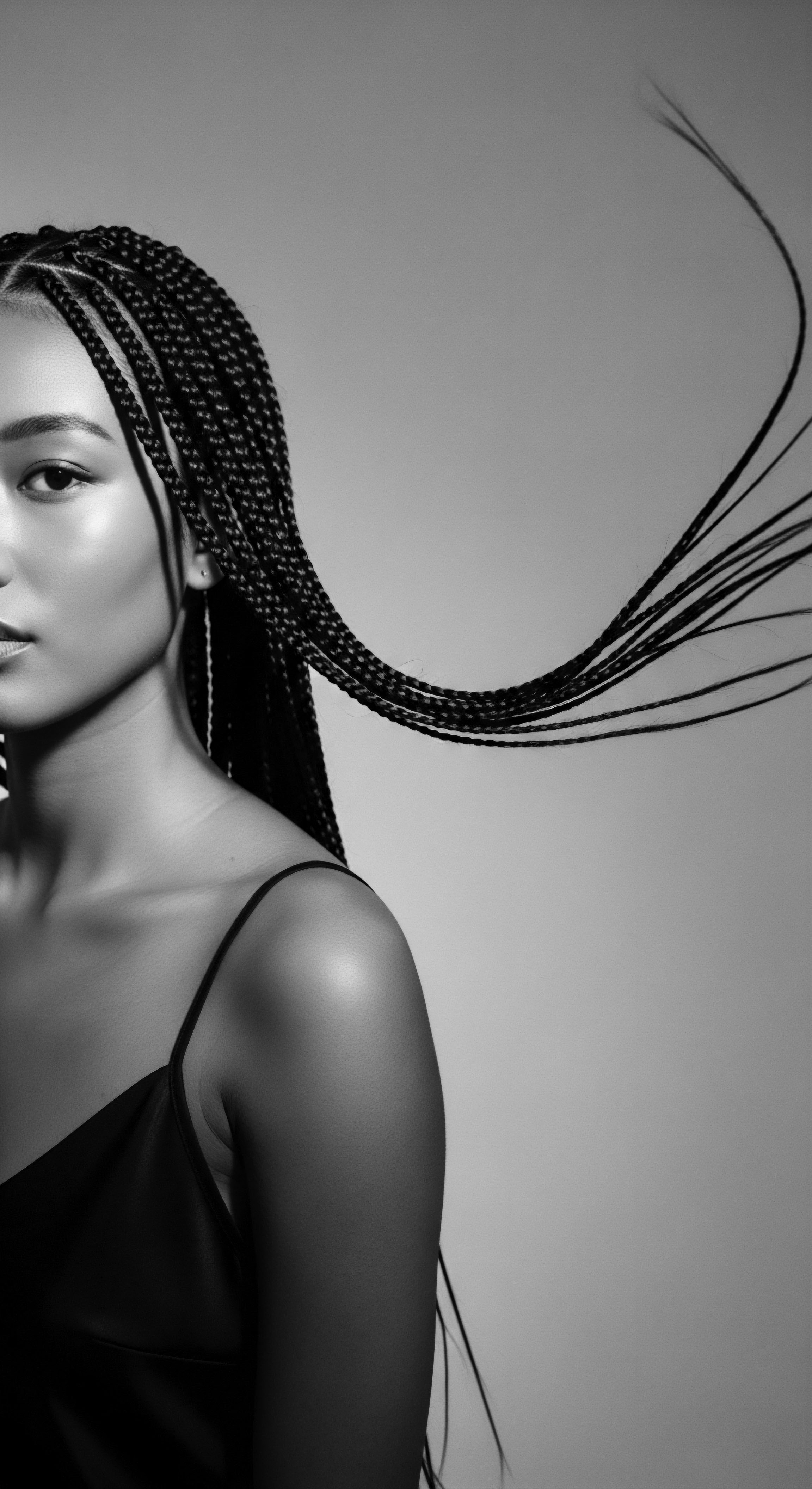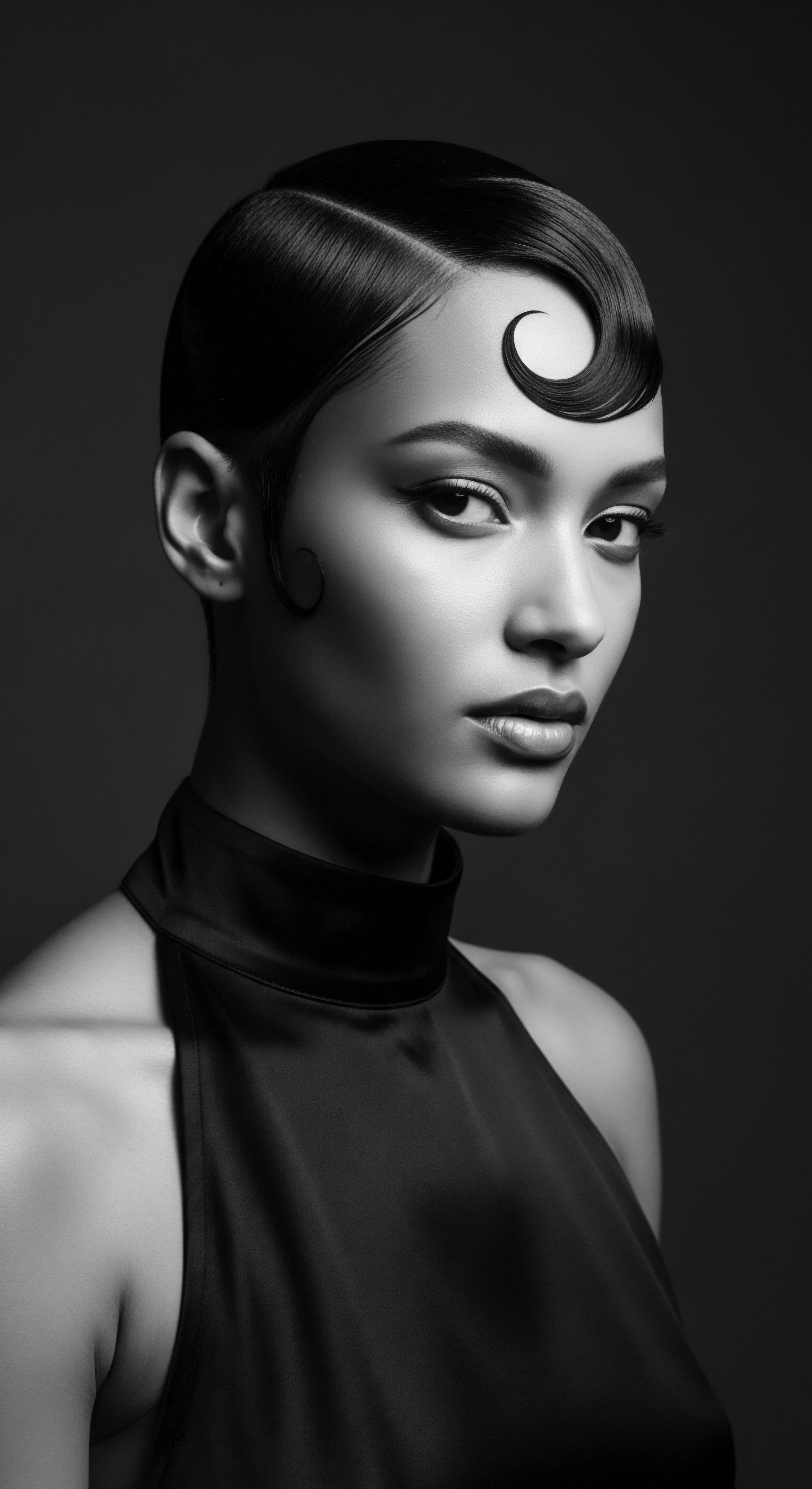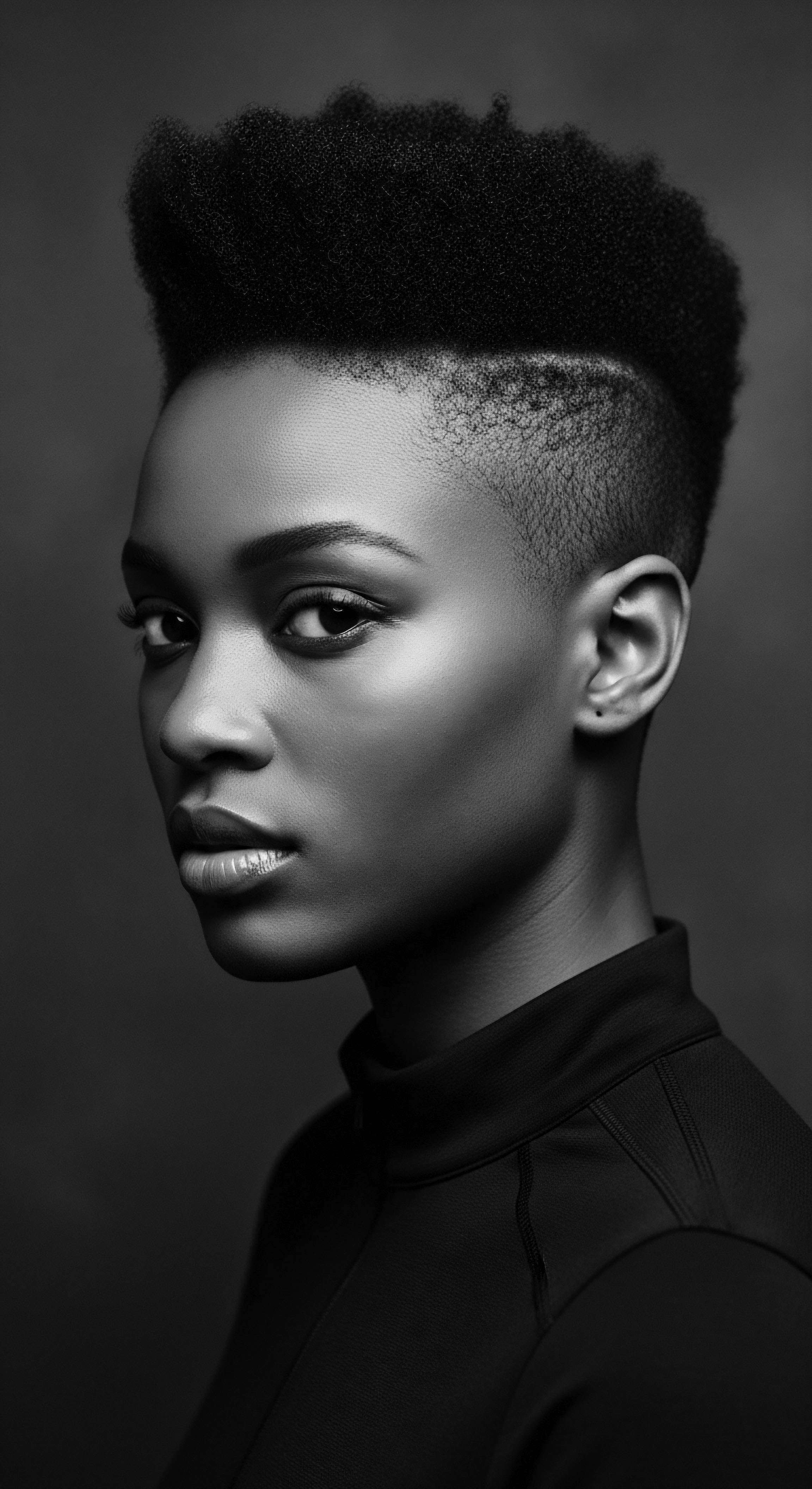
Fundamentals
The conversation surrounding textured hair often extends beyond mere aesthetics, reaching into the deep reservoirs of heritage and ancestral wisdom. Within this vast tapestry of knowledge, certain elements emerge from the natural world, silently offering their gifts across generations. One such gift, often overlooked in contemporary discourse, is the pigment known as Juglone.
At its core, Juglone is an organic compound, a quinone, primarily sourced from trees within the Juglandaceae family, most notably the Black Walnut (Juglans nigra) but also English walnuts (Juglans regia) and pecans. Its fundamental character lies in its vibrant coloration, presenting as a brownish-black or yellowish-brown substance, possessing a remarkable ability to impart its hue upon various surfaces.
This elemental designation, a natural dye, explains the pigment’s direct utility. It represents a coloration drawn straight from the soil and the tree, a deepening touch from the earth itself. The molecular structure of Juglone grants it a particular affinity for proteins, a characteristic that historically positioned it as a valued agent for coloring materials.
Beyond its dyeing capacities, understanding Juglone starts with recognizing its presence as a powerful botanical secretion. The chemical composition, a 5-hydroxy-1,4-naphthoquinone, bestows upon it not only its coloring strength but also unique biological properties.
Juglone is a natural pigment, a deepening touch from the earth, primarily sourced from the walnut family, revered for its ability to impart color.
Across diverse cultures, long before the advent of synthetic colorants, humanity turned to the botanical realm for beautification and adornment. The quest for rich, lasting hues led our ancestors to various plant sources. Among these, the walnut, with its staining hulls and leaves, held a special place.
The brown coloration observed on the hands of those harvesting walnuts provided a clear indication of this pigment’s potent nature. This observation, simple yet profound, guided early practices for hair and textile dyeing.
The preliminary comprehension of Juglone begins with its straightforward definition as a natural coloring agent. Its significance, however, unfolds as we consider its role in the early human relationship with natural resources, particularly how it offered a means of self-expression through color. The ancestral application of this pigment hints at a deeper understanding of the plant world, a wisdom passed down through generations, connecting elemental biology to the intimate rituals of personal care.

Intermediate
Moving beyond the simple recognition of Juglone as a natural dye, we consider its chemical attributes and the historical practices that illustrate its broader meaning. The chromophore properties of Juglone, tied to its quinone structure, enable it to absorb light and reflect color in the brown-black spectrum. Its dyeing capability stems from a reaction with the protein Keratin, a primary component of human hair and skin.
When Juglone encounters keratin, it forms a strong, stable bond, resulting in a lasting color. This is not a superficial coating but an interaction at a molecular level, allowing the pigment to adhere directly without requiring harsh chemical mordants that often compromise hair integrity.
Historically, the journey of walnuts, and by extension Juglone, across continents shaped its integration into varied hair care practices. While walnuts originated in Central Asia, their spread throughout Europe, North America, and other regions placed them within reach of diverse communities. Indigenous populations in North America, for instance, recognized the potent staining power of the native black walnut (Juglans nigra).
They utilized various parts of the tree, including bark, leaves, and particularly the green hulls, to produce dyes ranging from yellow to dark brown for fibers and hair. This traditional knowledge formed a continuous thread through generations, demonstrating a profound understanding of local flora and its capabilities.
The meaning of Juglone deepens when considering its specific application to textured hair. Textured hair, characterized by its varied curl patterns and unique structural needs, interacts with coloring agents differently than straighter strands. Juglone, being a non-oxidative dye, colors the external layers of the hair shaft, and perhaps some parts of the cortex, without lifting the cuticle aggressively.
This gentler action contrasts sharply with many synthetic permanent dyes that necessitate the opening of the cuticle with ammonia and the use of peroxide to strip existing melanin, which can lead to dryness and breakage, particularly for delicate textured strands. The implications for hair health within heritage-centered care practices become clear.
Juglone, a non-oxidative dye, interacts gently with textured hair’s keratin, coloring the strand’s outer layers without the harshness of synthetic processes, preserving hair integrity.
Traditional preparations of Juglone often involved simple, yet effective, methods. Communities prepared infusions from crushed green walnut hulls, allowing the natural pigment to leach into water. These liquid extracts were then applied to hair, sometimes repeatedly, to achieve desired shades of brown or black.
The effectiveness of these preparations varied based on factors such as the maturity of the hulls, the preparation method, and the natural porosity of the hair. This resourceful utilization of locally available ingredients speaks volumes about ancestral self-reliance and ingenious adaptation.
The significance of Juglone also extends to its non-coloring attributes. Preliminary studies suggest that Juglone possesses antimicrobial, anti-parasitic, and antifungal properties. While extensive scientific validation for these traditional applications is still developing, ancestral wisdom frequently linked plant-based remedies to holistic well-being, where a healthy scalp and protected strands formed an integral part of hair care. This holistic perspective, where hair care transcends mere aesthetics to encompass wellness and protection, resonates deeply with the spirit of natural, heritage-rooted practices.
| Aspect Source Material |
| Traditional/Ancestral Approach Green hulls of black walnuts gathered locally. |
| Modern/Scientific Understanding Extracts of Juglone, often purified or synthesized for consistency. |
| Aspect Preparation Method |
| Traditional/Ancestral Approach Crushing, boiling, or steeping hulls in water to create infusions or pastes. |
| Modern/Scientific Understanding Controlled extraction processes, sometimes formulating with specific pH adjusters for optimal color uptake. |
| Aspect Mechanism of Coloration |
| Traditional/Ancestral Approach Empirical observation of staining properties; direct adherence to hair. |
| Modern/Scientific Understanding Michael addition reaction with thiol moieties of cysteine residues in keratin. |
| Aspect Hair Health Implication |
| Traditional/Ancestral Approach Considered a natural way to color; less damaging than harsh alternatives. |
| Modern/Scientific Understanding Non-oxidative action means no cuticle damage from hydrogen peroxide or ammonia. |
| Aspect Shade Range |
| Traditional/Ancestral Approach Yellowish-brown to deep brown or black, dependent on natural hair color and application. |
| Modern/Scientific Understanding More predictable and consistent shades, potentially blended with other natural dyes. |
| Aspect The enduring legacy of Juglone in hair care demonstrates a continuous quest for beauty, moving from intuitive ancestral practices to scientifically informed applications, all rooted in nature's offerings. |
The intermediate understanding of Juglone therefore connects its specific chemical properties to its practical historical applications. It begins to show how this natural compound played a role in ancestral practices of appearance and self-care, particularly within contexts where reliance on indigenous plant knowledge was paramount. This connection grounds our present-day appreciation of Juglone within a long lineage of natural hair wisdom.

Academic
An academic engagement with Juglone necessitates a rigorous examination of its chemical identity, its biological mechanisms, and its profound cultural meanings within the expansive realm of hair heritage. Juglone, scientifically designated as 5-hydroxy-1,4-naphthoquinone, represents a distinct organic compound. Its molecular architecture, characterized by a quinone ring system and a hydroxyl group, confers upon it reactive properties that are central to its efficacy as a chromophore.
This particular structure allows Juglone to undergo oxidative polymerization when exposed to air, forming insoluble, intensely colored complexes. This chemical behavior is precisely what accounts for its remarkable ability to impart lasting brown-black pigments.

Mechanism of Chromatic Interaction with Keratin
The mechanism by which Juglone interacts with hair keratin, a fibrous protein, offers a compelling illustration of its dyeing capabilities. Unlike oxidative synthetic dyes that require a chemical reaction to penetrate the hair shaft, often utilizing hydrogen peroxide to strip natural melanin and ammonia to swell the cuticle, Juglone functions as a direct dye. It primarily binds to the amino acid residues, specifically the thiol groups of Cysteine, within the keratin structure via a Michael addition reaction.
This creates stable, covalent bonds between the pigment molecule and the hair protein. The process is one of deposition and adsorption onto the hair’s outermost layers, the cuticle, and to some extent, the cortex, rather than deep, disruptive penetration.
This non-destructive dyeing process is particularly salient when considering textured hair. Hair with tight curl patterns, such as those prevalent in Black and mixed-race communities, often possesses a more elliptical cross-section and can be inherently more susceptible to mechanical damage and dryness. Dyes that require extensive cuticle manipulation and melanin degradation can exacerbate these vulnerabilities.
Juglone’s gentler action preserves the structural integrity of the hair shaft, allowing for color enhancement without compromising the delicate balance of moisture and strength within these unique hair types. Its interaction contributes to a deepened hue, often appearing as rich brown or near-black, without the harshness associated with chemical processing.

Juglone’s Cultural Resonances ❉ An Ancestral Narrative of Ingenuity and Reclamation
The meaning of Juglone extends far beyond its chemical definition; it is deeply interwoven with the socio-historical fabric of textured hair heritage. Across time and geography, communities have adapted to their environments, transforming local flora into instruments of wellness and cultural expression. The black walnut tree (Juglans nigra), abundant throughout much of central and eastern North America, represents a salient example of this adaptive ingenuity.
Early American settlers, alongside indigenous populations, widely recognized and documented the dyeing properties of its green hulls. While explicit historical records detailing its use specifically as a hair dye among enslaved or post-emancipation African American communities are not always prominently cataloged in mainstream academic sources, the inferential evidence, grounded in ethnobotanical and historical studies of self-sufficiency, compellingly positions Juglone as a practical and culturally consonant resource.
During the periods of slavery and subsequent Reconstruction in the American South, African American communities faced severe restrictions on access to commercial goods and medical care. This necessitated a profound reliance on traditional knowledge and the resourceful utilization of local botanical resources for sustenance, healing, and self-care. As chronicled in works that explore African American herbalism and folk traditions, such as Lucretia VanDyke’s (2022) African American Herbalism ❉ A Practical Guide to Healing Plants and Folk Traditions, the transmission of ancestral plant knowledge, often adapting to new environments, was crucial for survival and the maintenance of identity.
Within this context, the readily available black walnut, a known natural dye for textiles and skin, would have been a logical and accessible choice for hair coloring. Its ability to deepen natural dark tones or obscure graying strands offered a means to adhere to aesthetic standards of neatness and dignity, which held considerable social meaning in a society that often sought to demean Black appearance.
Within African American communities, Juglone from black walnuts served as a practical, culturally relevant resource for hair coloring, embodying ancestral ingenuity and self-reliance in sustaining appearance and dignity.
This practical application of Juglone for hair, while perhaps not yielding the vibrant spectrum of commercial dyes, provided a profound cultural utility. It became an act of self-determination, a quiet yet powerful affirmation of self-worth and identity when external forces sought to strip away such expressions. The deliberate act of preparing and applying a natural dye, a ritual connected to the land and to a legacy of resourcefulness, served to reinforce community bonds and preserve cultural continuity.
This particular historical example, rooted in the resourcefulness of communities adapting ancestral botanical wisdom to new environments, illuminates Juglone’s role as a silent accomplice in maintaining beauty and identity amidst adversity. The very act of collecting the hulls, preparing the dye, and tending to one’s hair with such natural elements was a continuation of ancient practices of self-sustenance and cultural grounding.
Moreover, the use of Juglone aligns with a broader historical narrative of Black women, especially, resisting Eurocentric beauty standards. The pressure to conform to straight hair textures often led to damaging chemical processes. Natural dyes like Juglone offered an alternative, a way to enhance hair’s appearance without succumbing to practices that compromised hair health or inherent curl patterns.
This choice represented a quiet rebellion, an assertion of an aesthetic that honored natural texture and color. This deeper understanding of Juglone’s role in hair care becomes a testament to the enduring spirit of resilience.

Beyond Chromatic Properties ❉ Therapeutic and Protective Dimensions
Beyond its primary function as a colorant, Juglone possesses secondary metabolites with reported pharmacological activities, further elevating its meaning within holistic hair care. Preclinical studies indicate Juglone’s antimicrobial, antifungal, and anti-parasitic activities. While direct applications to human hair health require more extensive clinical research, these properties suggest a potential historical benefit to scalp health.
A healthy scalp forms the foundation for thriving hair, particularly for textured hair types that might be prone to certain scalp conditions due to their unique morphology and care practices. The presence of such compounds in natural preparations may have contributed to overall scalp hygiene, reducing conditions that could impede hair growth or cause discomfort.
- Antimicrobial Action ❉ Juglone’s ability to inhibit microbial growth could have served to cleanse the scalp, mitigating issues arising from bacterial or fungal imbalances, such as those that can contribute to dandruff or other irritations.
- Antifungal Properties ❉ The documented antifungal activity of Juglone offers a protective dimension, potentially guarding against common fungal infections that affect the scalp, thereby preserving the health of hair follicles.
- Antioxidant Compounds ❉ Walnut extracts, including Juglone, contain other compounds like flavonoids and tannins, which possess antioxidant properties. These compounds may help protect hair and scalp cells from oxidative stress, contributing to the longevity and vibrancy of strands.

The Interplay of Juglone with Diverse Hair Structures
The interaction of Juglone with the diverse architecture of textured hair demands specific consideration. Textured hair, spanning a spectrum from wavy to tightly coiled, exhibits variations in cuticle structure, porosity, and sebaceous oil distribution. The elliptical cross-section of highly coily hair, compared to the more circular form of straight hair, means that natural oils struggle to travel down the hair shaft, often leading to increased dryness.
When a non-oxidative pigment like Juglone is applied, its surface-level deposition allows for coloration without disrupting the hair’s natural moisture balance. This is a critical distinction, as processes that strip natural oils or damage the cuticle can severely compromise the health of textured hair, leading to brittleness and breakage.
The color imparted by Juglone can vary subtly across different hair types and initial hair colors. On lighter or graying strands, Juglone produces a more pronounced brown or black shade. On already dark textured hair, it deepens the existing color, adding a richer, more luminous quality without altering the inherent hue drastically. This nuance in coloration makes Juglone a versatile tool within a natural hair care regimen, offering enhancement rather than a complete transformation, thereby honoring the hair’s original state.
- Cuticle Integrity ❉ Juglone’s direct binding to keratin avoids harsh opening of the cuticle, preserving the hair’s protective outer layer, which is vital for moisture retention in textured strands.
- Melanin Preservation ❉ This pigment does not lighten hair by oxidizing melanin; instead, it adds a layer of color, maintaining the natural melanin within the hair shaft, leading to more resilient strands.
- Complementary to Hair’s Natural Form ❉ By enhancing existing dark tones, Juglone supports the acceptance and celebration of natural hair colors within Black and mixed-race communities, aligning with the philosophies of the natural hair movement.
The academic contemplation of Juglone also extends to ethical considerations and sustainability. The resurgence of interest in natural ingredients necessitates responsible sourcing of walnuts, ensuring ecological balance and supporting communities involved in their cultivation and harvesting. The long-term stability of Juglone as a natural dye, while generally good, can be affected by light exposure, leading to some fading over time. This characteristic, however, is often accepted within the ethos of natural beauty, which prioritizes health and sustainability over permanent, chemically induced color.

Reflection on the Heritage of Juglone Pigment
As we draw our exploration of Juglone Pigment to a close, a sense of enduring respect for the ingenuity of our ancestors settles. This humble compound, drawn from the tenacious walnut tree, stands not merely as a chemical entity but as a living testament to a continuous lineage of care and self-determination. It whispers stories from generational hearths, of hands that knew the earth intimately, transforming its offerings into tools for well-being and visual expression.
The journey of Juglone, from its elemental biology to its resonance within Black and mixed-race hair experiences, is a narrative woven with resilience. It speaks to a time when beauty was found in the authenticity of what the earth provided, a profound understanding of plant life that sustained communities through immense challenges. The choice to use natural pigments, whether for textile or hair, represented an act of sovereignty, a means of maintaining dignity and cultural markers when external forces sought to erase them.
Juglone stands as a living testament to ancestral ingenuity, a thread connecting elemental biology to the profound cultural meanings within textured hair heritage.
In a world increasingly seeking to reconnect with natural rhythms and ancestral wisdom, Juglone Pigment offers more than just color; it offers a pathway to remembrance. It invites us to consider the hands that first crushed the walnut hulls, the communal rituals surrounding hair preparation, and the quiet strength found in adorning oneself with nature’s palette. Its legacy encourages us to appreciate the deep intelligence embedded in heritage practices, where scientific understanding and soulful care often walk hand-in-hand. This pigment, a gift from the Earth, serves as a poignant reminder that the true beauty of our textured strands is inextricably linked to the stories they carry, the wisdom they embody, and the unbroken thread of our shared human story.

References
- Byrd, Ayana, and Lori L. Tharps. Hair Story ❉ Untangling the Roots of Black Hair in America. St. Martin’s Press, 2001.
- Cozzo, David N. Ethnobotanical Classification System and Medical Ethnobotany of the Eastern Band of the Cherokee Indians. University of Georgia, 2005. (Cited indirectly through search results discussing ethnobotany in the Southern Appalachians, which cover the context of Juglans nigra use in regions inhabited by diverse communities).
- Green, Clarence V. African American Herbalism ❉ A Practical Guide. Independently published, 2021.
- Khan, Shahid, et al. “Recent Advancements in Natural Plant Colorants Used for Hair Dye Applications ❉ A Review.” Cosmetics, vol. 9, no. 6, 2022, pp. 132.
- Morton, E. L. Folk Medicine in the Southern United States. University of Tennessee Press, 1978. (General reference for regional ethnobotanical practices).
- Roia, F. “The Use of Plants in Hair and Scalp Preparations.” Economic Botany, vol. 20, no. 1, 1966, pp. 17-30.
- Shakyawar, D. B. et al. “Juglans nigra ❉ Chemical constitution and its application on Pashmina (Cashmere) fabric as a dye.” Journal of Chemical and Pharmaceutical Research, vol. 6, no. 3, 2014, pp. 883-888.
- VanDyke, Lucretia. African American Herbalism ❉ A Practical Guide to Healing Plants and Folk Traditions. DK, 2022.
- Yadav, Nita, Rajesh Yadav, and Murli Dhar Kharya. “Preparation and evaluation of natural hair colorant.” World Journal of Pharmaceutical Research, vol. 13, no. 18, 2024, pp. 488-500.
- Zanke, Ashwini A. et al. “A Review On The Natural Resources Use As Hair Colour And Hair Dye.” International Journal of Science and Research Archive, vol. 2, no. 1, 2021, pp. 28-31.
